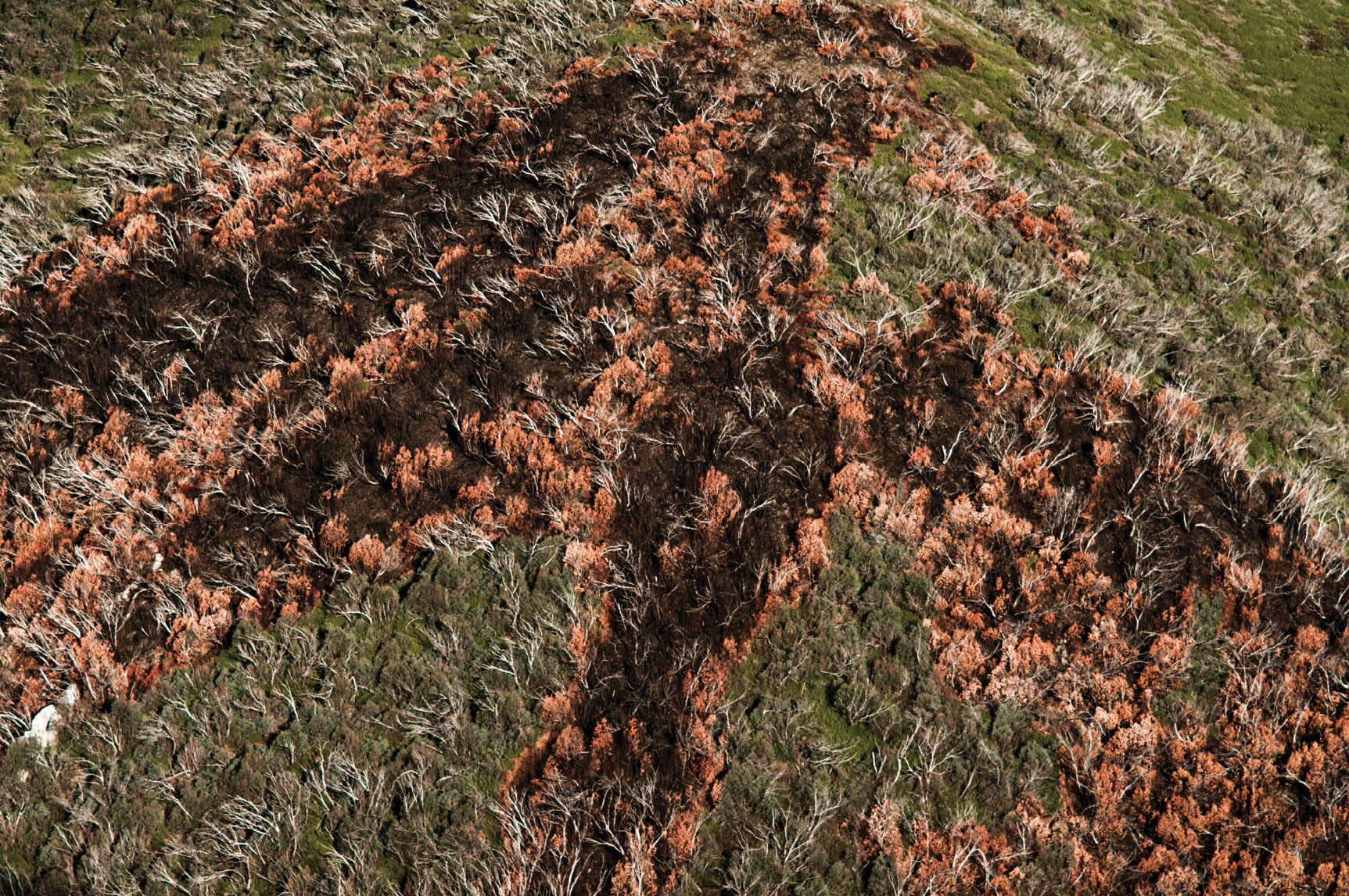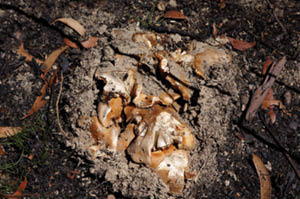


Competition: March 2013 Non-Landscape
Fire Patterns on FeathertopRyan Judd
BURNT AGAIN!Steve Alton

The fragility of our burnt landscape immediately after fire, and for as long as it takes for widespread rain, is often misunderstood. It’s a dangerous place, with ash pits a metre or more deep, falling trees and branches, and unstable rock surfaces. Once-familiar routes may be hazardous, steps and stairs are burnt or damaged, bridges are gone, and signposts are incinerated. It’s also a place where we can wonder at the fire adapted evolutionary miracle that surrounds us.
The ashes of recent bushfires lie thick on the ground, grotesque twisted stems protrude, and thick gum trees are silhouetted sharply against rocks black-ened with soot. Here and there the fire had such in-tensity that the ground itself has erupted as what little moisture remained was explosively heated, released and vapourised. Some rock surfaces are exfoliated, destroying the hard exposed surface accreted over decades. Trees that have survived many fires (and the increase of regular burning contributes to this), may have extensive hollowed roots as well, some providing refuge for animals. These tunnels can burn under-ground in intense bushfires, and eventually the tree will fall. It can take some time. Regrowth can increase its lop sided weight, and the tree will fall without warn-ing a considerable time after fire. In the trees, limbs and hollow branches are burnt out or left hanging as “widow makers”, waiting to fall in the slightest wind or when rain increases the unsustainable weight. Most fire fighting injuries are sustained in mop up opera-tions from these sometimes invisible weaknesses in trees.
When burnt our tough Australian bush is at its most vulnerable. Over thousands of hectares, animals have dispersed or suffered. Vast insect populations have been wiped from the food chain Birds now desert the leafless trees. After their initial feast on carcasses, carnivores will have to search further and further for food. Given time, things will improve, but until then the burnt forest is in a very delicate state.
Within this chaos of charcoal and ash are dormant seeds and the stumps and trunks of plants that have evolved strategies to survive. The eucalypt forest that
covers the Greater Blue Mountains World Heritage Area is renowned for adaptation to bushfire over millennia. Only a few of the 100 or so gum trees that grow here have little or no resistance to fire. Thick insulating bark protects some trees, some revive by growing shoots from epicorms, (on the trunk and branches) lignotubers (modified stem or root at the soils surface or below) or rhizomes (roots well below ground level), even a spate of flowering of some plants can begin within weeks of the fire passing.
Other species also have resistance or reliance on fire, or require heat, smoke or fertile ash beds to re-generate. Acacia seeds require the intensity of fire to breach the hard woody shell of their seed. After fires, Banksia crack open thick follicles and release winged seed to float onto the bare ground, and pink fannel fowers Actinotus forsythii germinate profusely when soaked in bushfire smoke infused with rain! Rain can be a blessing, but heavy rain will scour unprotected soil, washing soil, nutrients and seeds away, leaving bare unprotected areas.
Some species are killed by fire, but their seeds are not, and if enough time elapses between fires to grow again to maturity and set seed itself, the species will survive. Species decline from fire depends on the interval between fires. If burnt too often, some species will never return. Weed introduction at this vulnerable time can take a heavy toll, often out competing native species. The time taken to fully revive the landscape is measured in years or decades.
It all takes time.
Much of the biomass is incinerated during the fire Nutrients like nitrogen (essential for green plant growth) are turned to gas and disappear in smoke. Potash is essential for strong cellular development of plants and is found in abundance in the fine charcoal. Other essential elements are either concentrated or lost. Some of our plants, notably Acacias, have soil mi-crobe associations in their roots that produce nitrogen and release it into the soil. Sometimes called pioneer plants, as they are often first to re grow, these plants improve the soil and provide the cover essential for
28 | BWA December 2013





Steve has lived in the Blue Mountains for 25 years, exploring the landscape and sharing it with visitors from around Australia and the world. “I think the tradition of bushwalking was born here, in the way that bushwalkers respect the environment, and come back and enjoy it over and over: The Blue Mountains really is a natural wonderland made for bushwalking”
News just in
Just before publishing this edition, Steve sent through this image of the fungus starting to emerge. You can see that some animals are already feeding on it - all along Hat Hill Road.
BURNT AGAIN!Steve Alton
slower germinating plants to survive. Even in our san-dy nutrient-deficient soils the mechanisms to survive fire are subtle, complex and overall successful. Grass trees are stimulated by fire that completely destroys their long delicate leaves, with their tall flower spikes appearing a few months after fire. In particular, fungus become more apparent across a range of habitats as there is little to hide the fruiting bodies from sight. Bright green ferns sprout from rock crevices, their tough roots protected by rock or buried deep in the soil.
It could be some months before NPWS allow or encourage visitors to return to burnt areas. See www.nswnationalparks.nsw.gov.au. Assessment of track infrastructure, and vigilance about dangerous trees near tracks and camping areas will be foremost, but it’s really widespread and gentle rain that restores the natural world. If you are visiting an area that has
been recently burnt and re opened to visitors, please keep to marked tracks. Don’t damage the track edges, as many seedlings and sprouts will emerge if undis-turbed. Keep out of burnt areas, as trees will continue falling for a long time, there are still deep ash pits where hollow stumps have burnt without a trace, and fragile soils need your protection.
It’s just the beginning of the fire season, and we have seen tragedy and loss across the villages of the Blue Mountains and elsewhere. Our landscape has evolved with fire as a component since time unre-membered, and the natural regenerative processes resulting from what looks like annihilation proceed at their own pace.
Keep safe and enjoy the renewal and revival of an ancient diverse and beautiful landscape.
Steve Alton
BWA December 2013 | 29